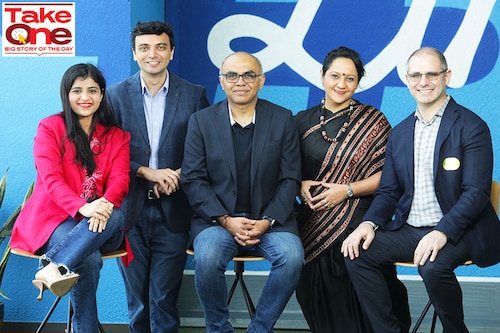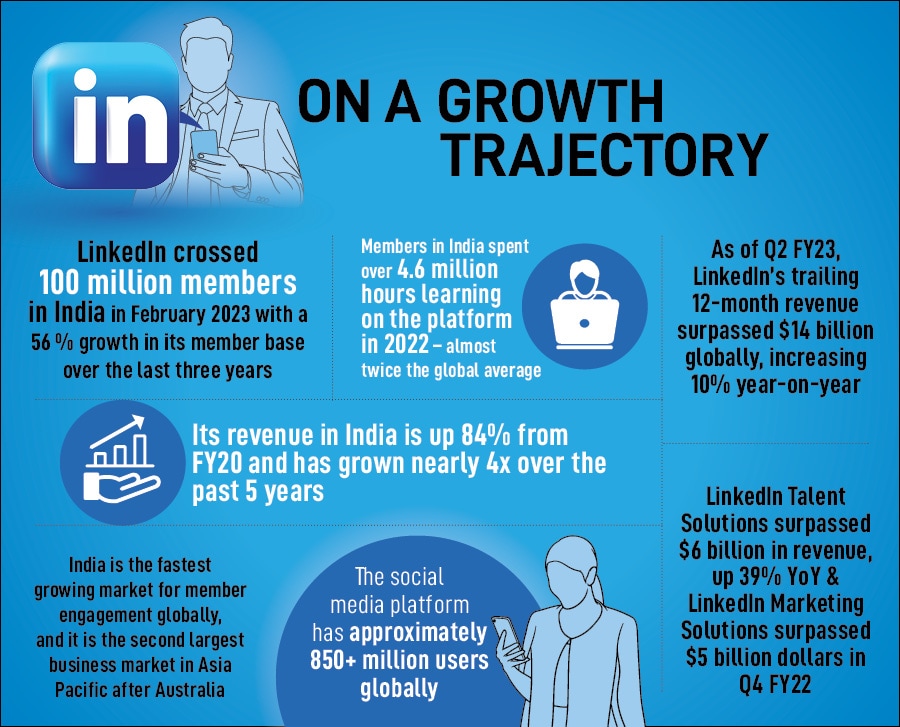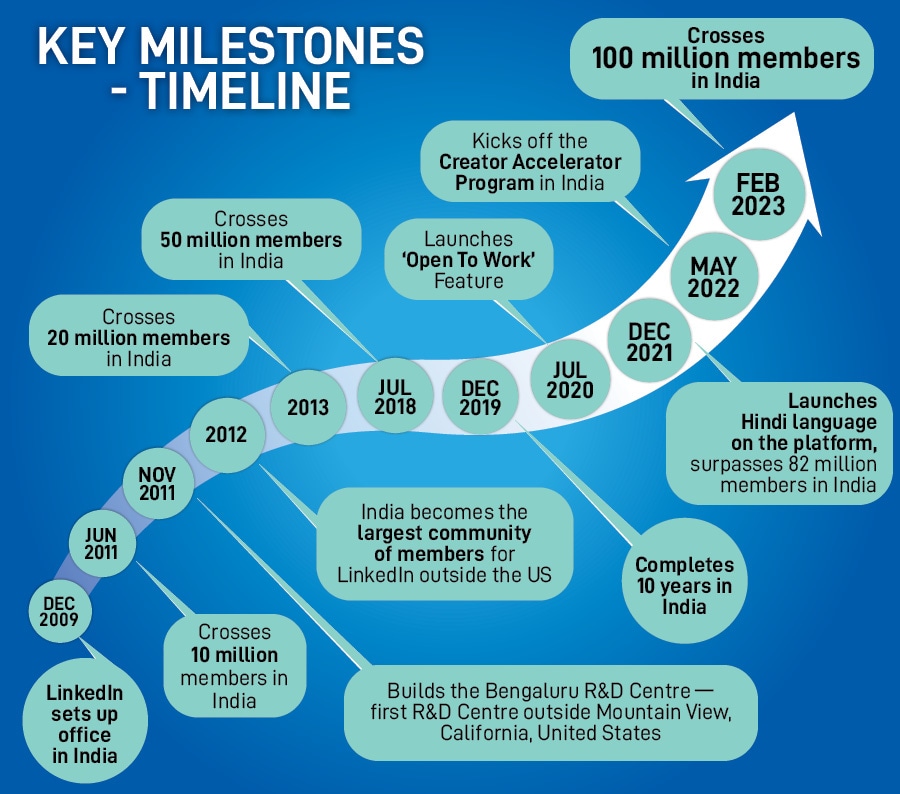There are 100 million Indians on LinkedIn. Here's how the Microsoft-owned platfo
The social media platform for employment and professional connections, which recently launched in the Hindi language, is now betting big on the creator economy


In 2009, when social media platform LinkedIn launched its first office in India, there were only four employees. Back then, Daniel Shapero—who was the then vice president, product, at LinkedIn—was one of the only global leaders to have visited India.
Thirteen years later, along with Ashutosh Gupta, India country manager of LinkedIn, Shapero was cutting a cake celebrating a massive milestone—100 million members in India. Microsoft-owned LinkedIn’s India growth story, particularly in the last couple of years, has been phenomenal.
Gupta, who joined the company in 2013, says India has 20 million members, and “it has been a 5x growth in the last 10 years. Last January, we were at 76 million members, and right now, it’s 100 million". Apart from members and engagement, the company has grown in terms of revenue as well—84 percent from FY20. LinkedIn has not revealed exact revenue numbers. India is the fastest growing market for member engagement globally, and it is the second largest business market in Asia Pacific after Australia.
Shapero is not surprised by the pace at which the market is growing. “We see India as a market that is critical to where we are going. We’ve made some focussed investments here," the chief operating officer at LinkedIn tells Forbes India, during his recent visit.
One of the main reasons for growth, reckons Shapero, is that “In the last three years, we are seeing LinkedIn become successful with members and companies across industries and in a range of locations in India. In our early days, it was a tool used mostly in metro cities by people working at multinationals." The platform has seen a 30 percent year-on-year growth in new members.
The focus of the platform from a user point of view is to create respectful communities and improve accessibility. Keeping accessibility in mind, says Ajay Datta, head of product, LinkedIn India, “In December 2021, we launched LinkedIn in Hindi. The idea is to make the platform more approachable and improve user experience." Currently, the platform is available in 26 languages globally, but moving to Hindi is a massive investment in the Indian market.
Primarily, the platform has two major revenue streams: Talent solutions and marketing solutions, both of which are B2B offerings. The former provides innovative recruiting tools using data points from the community, helping companies acquire the right talent. Marketing solutions is where companies advertise on the platform—either via targeted InMail or sponsored posts on the feed.
For talent solutions, LinkedIn provides actionable insights to the customer, which helps them make decisions from a strategic point of view. Ruchee Anand, senior director—India talent and learning solutions at LinkedIn explains, “Our end-to-end solution helps the recruiter right from the stage of planning and understanding the talent pool available, understanding talent migration trends, where talent is available, and how to leverage the platform and reach out to the right kind of talent in a targeted manner." Once hired, offerings such as skilling via LinkedIn Learning or Employee Engagement Survey via Glint help both employees and employers.

Globally, its marketing solutions have surpassed $5 billion dollars in annual revenue in Q4 FY22. “In the B2B digital advertising market, we are one of the Top 3 players, growing 3x faster than the category itself. Customers choose us for the reach and return on investment that they get," explains Gupta.
The revenue model for large clients is mostly subscription-based, where they sign up for a host of solutions basis their requirements in the form of long-term multi-year contracts. Some of their clients include IT companies like Infosys, TCS and Wipro, and edtech startups like upGrad and Simplilearn, apart from other companies and MNCs. These solutions and offerings, make the platform a lot more than simply a ‘social media’ platform. “Most of these players have a full-funnel marketing approach—from raising awareness to converting them to users," explains Gupta. “We do this via promoted InMail, explaining the offering and sponsored updates on the feed without killing the user experience. The key, however, is targeted marketing—you only want to reach to a precise audience, not everybody… that is something we excel at providing because of the data we have."
Hitesh Rajwani, founder & CEO, Social Samosa Network explains that the massive engagement on content, high average time spent on the platform and lower count of fake profiles and bots have contributed to this interest on LinkedIn. “However, advertising on the platform in India is still picking up because of the perception that it’s slightly expensive than other platforms. But like I mentioned, the salience and precision the platform can drive is second to none."
One of the biggest emerging revenue streams is LinkedIn’s deep sales platform, which includes LinkedIn Sales Navigator and LinkedIn Sales Insights. Via these products, the idea is to help sellers uncover and understand buyer intent by providing insights that can change the game for sales teams and create a culture of top performers.
Given the amount of data LinkedIn has access to, how are privacy concerns addressed? Datta states that the platform is completely General Data Protection Regulation compliant. Secondly, he explains, “We have a privacy by design approach, which means when a user is taking any action, we tell the member that this is what we are going to use your data for. That is how we ensure complete transparency."
The creator accelerator programme for LinkedIn was launched in May 2022. The platform has made an investment of $25 million globally for the creator programme. Since its launch in India, it has seen a slew of creators across various industries ranging from business to entertainment and sports, joining the platform. Mithali Raj, the former captain of the Indian women’s cricket team is also a creator on LinkedIn. She says, “LinkedIn is the perfect platform to share my experiences and opinions and connect with like-minded people, while allowing me to go beyond the sports community and reach out to a broader audience."
Over time, LinkedIn members are looking for diverse content on the platform. Pooja Chhabria, head of editorial—APAC, LinkedIn says, “We have seen a 2x increase in knowledge-based content that people are sharing on the platform." There are investments being made in products for the creator community, for ease of content creation. “Once you turn on creator mode, you have access to a bunch of features including, videos, newsletters, live mode, conducting audio events and a lot more," adds Chhabria. There has been a 10x growth in newsletters being launched on the platform.

Along with these features, creators also get access to analytics and insights, to understand what works and what doesn’t. In order to help these professionals, there are in-house managers who help creators with what kind of content can be posted and how to make the most of the platform. “Additionally, we also conduct workshops for creators in order to educate them about features they could use and how they can engage better with their audience on LinkedIn," she adds. Eventually, it leads to monetisation opportunities for creators as well.
This year, skilling was yet again one of the focus areas for Finance Minister Nirmala Sitharaman during her Union Budget speech in February. Employers are now looking for skills more than educational qualification, and LinkedIn is investing and innovating to ensure companies find the right professionals.
“Earlier," explains Shapero, “companies would search by job titles such as ‘software engineers’. But now, they can search by skills—everyone who knows ‘Java’ or ‘Python’. This is a behaviour change in the way recruiters hire, and thiss approach also allows the company to hire a more diverse talent pool." Skill-based hiring is also helping people move jobs, within their own companies. “Career paths are no longer linear, more and more people are taking less traditional routes," adds Shapero.
With the demand for upskilling, LinkedIn Learning has become a very popular product, with close to 40 million paid subscribers globally. “Content for the same is primarily English at the moment, but localisation efforts for India are in the pipeline as well," adds Anand.
While LinkedIn is a great platform for people who are already professionals, Shapero is most excited about a segment that they hope to tap into: Students or people who aspire to become professionals. He reckons, “I think skill is the currency to help people breakthrough and open doors to many more opportunities."
The company wants to continue in its vision of creating economic opportunities for members of the global workforce. Shapero says, “Earlier it was about creating a professional profile, making connections and finding jobs, then it became a platform to share content and discover professional news. Increasingly it’s become a place for people to share professional expertise, and turn into creators. While the product has evolved, the core objective remains consistent."
First Published: Feb 27, 2023, 16:25
Subscribe Now